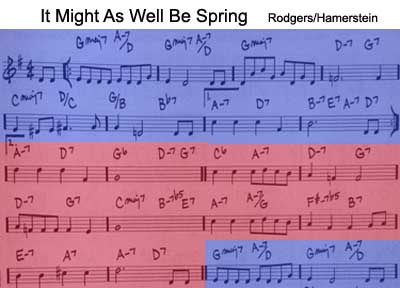« Mike Marshall on switching instruments |
Main
| Learn To Play In Every Key (Part One). Baron Collins-Hill »
 April 10, 2014 | Keying into FFcP April 10, 2014 | Keying into FFcP
So you've been practicing your FFcP Scales, mastering the 3rd, 4th, and arpeggios, major and minor, and you feel pretty good about them. Now you're in a funk because despite the pride you have in this accomplishment, you wonder what's next? What do I do with these skills?
From a purely physical, finesse and flexibility point of view, the FFcP drills could almost stand on their own. Your 3rd and 4th fingers are more independent, you've lost the initial fear of the upper fretboard, but now you wonder, how do I use these to make music?
We advocate leaving some of these in your daily practice routine, but we want to suggest incorporating them directly into the literature you're playing, be it jazz standards, fiddle tunes, or improvising church or pop/rock music. You might already be doing this, diving practicing into FFcP and songs, but keeping them as separate entities. We'd like to encourage you to think key regions (tonal centers) and scale fodder.
Let's say you're working on the great Rogers & Hammerstein song "It Might As Well Be Spring." It's a fairly simple tune harmonically, stripped of a few stray 'ii V7 I' harmonic detours it's just two keys. In G Major, it's G and C Major.

We've colored the section blue for G and red for C. So what you want to do is start your practice drilling the FFcP keys of G and C Major, and get them into your fingers before playing the song.
 
Next step is to take what you've internalized as G and C pathways and start on your improvisation. Don't worry about the color tones of the secondary dominants for now, just concentrate on the two keys.
When this is comfortable, try some different inversions of the FFcP, in this case, we move from the FFcP 3 to the FFcP 2, up two frets. Again practice them before returning to the song.
 
This seems simplistic, but it's an approach that can make your practice sessions more interesting, focus on specify keys, and get comfortable moving your "base" up the fretboard and back.
Try the same thing with a song like "These Are a Few of My Favorite Things." Take some time to isolate the keys, yourself first. You'll need three keys, E Minor, G Major, and E Major. Drilling through the FFcP scales in these keys will go miles in not only getting comfortable with your own pathways, but the 'ii vi7 ii7 I' part of your FFcP drill will help you to communicate important chord tones.
Further:
Four Finger Closed Position FFcP
FFcP vs Closed Fingerings Scales
Raking it in. Autumn Leaves Pt. 2
Sneaking Theory
Approaching Improvisation
Posted by Ted at April 10, 2014 3:01 PM

Disclaimer: In the 'Information Age' of the 21st Century,
any fool with a computer, a modem, and an idea can
become a self-professed 'expert." This site does not
come equipped with 'discernment.'
|



